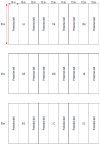Effect of Sowing Date on the Development of Lacy Phacelia (Phacelia Tanacetifolia Benth.)
- PMID: 36432906
- PMCID: PMC9694782
- DOI: 10.3390/plants11223177
Effect of Sowing Date on the Development of Lacy Phacelia (Phacelia Tanacetifolia Benth.)
Abstract
Experiments with lacy phacelia (Phacelia tanacetifolia Benth.) were carried out in the period 2017-2021, during which the effect of sowing date on the stand development was assessed (height, coverage, accomplishment of individual growth stages, and weed infestation). It was demonstrated that the sowing date affects the stand growth and development. In earlier sowing dates, plants developed slower than in later sowing dates but reached a greater average height (926 mm). The lowest height (802 mm) was exhibited by plants from May (sowing 3). The third sowing date also showed the worst stand canopy closure and at BBCH 31, the stand canopy closure in Sowing 1, 2, and 3 was 82.3%, 77.8%, and 67%, respectively. The third sowing date was also the highest weed infestation. The effect of sowing date on yield and yield parameters was also monitored (weight of a thousand of grains and germinative capacity). Based on the measured data, it can be concluded that the influence on the weight of thousands of grains was minimal and in germinative capacity. Significant differences were recorded only in first year in which the germinative capacity of plants from the later sowing dates was reduced.
Keywords: growth and height intensity; phacelia; sowing date; weed infestation; yield parameters.
Conflict of interest statement
The authors declare no conflict of interest.
Figures



















Similar articles
-
Chromium (VI) accumulation in different plant organs of Lacy Phacelia (Phacelia tanacetifolia Benth.): Implications for phytoremediation.BMC Plant Biol. 2025 Apr 2;25(1):414. doi: 10.1186/s12870-025-06471-4. BMC Plant Biol. 2025. PMID: 40175928 Free PMC article.
-
Influence of Sowing Time and Weed Management Practices on the Performance and Weed Dynamics of Direct Drum Seeded Rice.ACS Omega. 2023 Jul 10;8(29):25861-25876. doi: 10.1021/acsomega.3c01361. eCollection 2023 Jul 25. ACS Omega. 2023. PMID: 37521617 Free PMC article.
-
Nitrogen compounds in Phacelia tanacetifolia Benth. honey: First time report on occurrence of (-)-5-epi-lithospermoside, uridine, adenine and xanthine in honey.Food Chem. 2018 Jul 30;255:332-339. doi: 10.1016/j.foodchem.2018.02.093. Epub 2018 Feb 17. Food Chem. 2018. PMID: 29571484
-
Effect of Sowing Date on the Growth Characteristics and Yield of Growth-Constrained Direct-Seeding Rice.Plants (Basel). 2023 May 6;12(9):1899. doi: 10.3390/plants12091899. Plants (Basel). 2023. PMID: 37176958 Free PMC article.
-
Effect of sequential applications of foliar nutrients, biofertilizers and sowing dates on the incidence of corn stem borers in Egypt.Meded Rijksuniv Gent Fak Landbouwkd Toegep Biol Wet. 2002;67(3):487-97. Meded Rijksuniv Gent Fak Landbouwkd Toegep Biol Wet. 2002. PMID: 12696416
References
-
- Żuk-Gołaszewska K., Wanic M., Orzech K. The role of catch crops in field plant production—A review. J. Elem. 2019;24:575–587. doi: 10.5601/jelem.2018.23.3.1662. - DOI
-
- Błażewicz-Woźniak M., Konopiński M. Influence of ridge cultivation and phacelia intercrop on weed infestation of root vegetables of the Asteraceae family. Folia Hort. 2012;24:21–32. doi: 10.2478/v10245-012-0003-3. - DOI
-
- Doltra J., Olesen J.E. The role of catch crops in the ecological intensification of spring cereals in organic farming under Nordic climate. Europ. J. Agron. 2013;44:98–108. doi: 10.1016/j.eja.2012.03.006. - DOI
-
- Zaniewicz-Bajkowska A., Rosa R., Kosterna E., Franczuk J. Catch crops for green manure: Biomass yield and macroelement content depending on the sowing date. Acta Sci. Pol. Agric. 2013;12:65–79.
LinkOut - more resources
Full Text Sources

